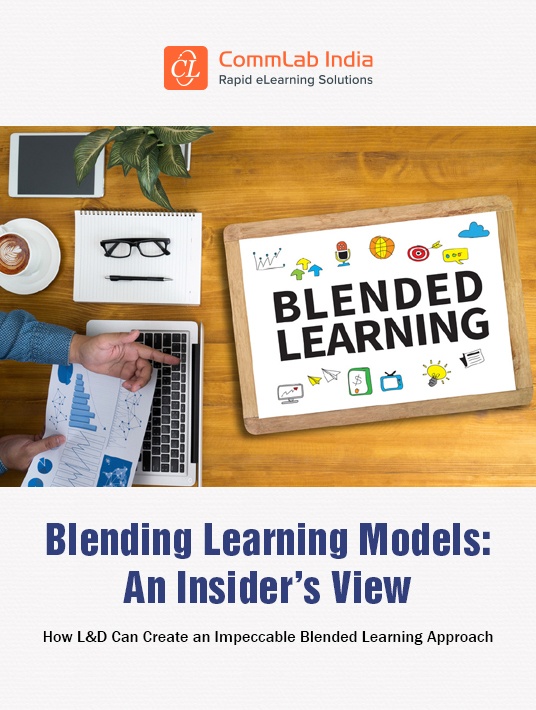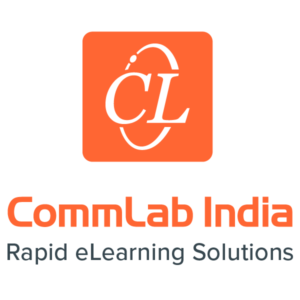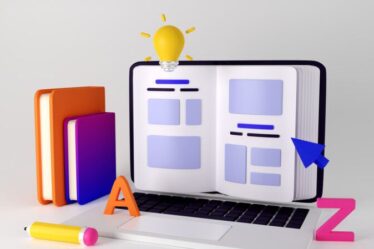
Discover How Blended Learning Can Help Power A Personalized Learning Experience
There’s a lot of buzz today around personalized learning (a personal way to learn) that is first and foremost about the learner; it is learner-centric, helping learners drive their own learning. If personalization is the goal, then blended learning is the means to that goal!

eBook Release
An Insider’s View On Blending Learning Models
Discover how blended learning enhances training, the best blended models, and more.
Blended learning allows companies to provide a personalized learning experience to learners at a fraction of the cost and time [1], leveraging technology to engage and support each learner’s unique learning needs. In other words, blended learning is more a « pathway » to support personalized learning than a learning strategy.
In this article, I will be talking about the 6 features of personalized learning that can be implemented through a blended learning strategy.
What Is Personalized Learning?
But before that, let’s define personalized learning.
|
Now that the definition is out of the way, let’s go deeper into the features of personalized learning and how blended learning can help tailor a personalized learning experience.
How Does Blended Learning Fuel Personalized Learning?
1. Instant Access To The Training Material Regardless Of Time/Place
Paper-based material, and even eLearning courses at times, can be overwhelmingly vast, which makes searching for the right information a bit of a pain. In our fast-paced world, with time at a premium, employees would like to have immediate access to the right information at the right time, especially after the training winds up, to help them perform well in their jobs.
Instead of making learners wade through a huge pile of training material, a personalized learning strategy ensures that the information is organized into manageable sections for the learner to easily search and access.
How Blended Learning Can Help
One of the biggest advantages of blended learning is that not all training content is in a single format. Organizations can choose to offer—along with a blend of traditional Instructor-Led Training (or virtual ILT) sessions and self-paced eLearning courses—searchable microlearning assets and job-aids for instant access to the required content (performance support) [2].
The microlearning format can be used to package important nuggets of information from the training—be it classroom-based or eLearning—into PDFs, infographics, videos, flow-diagrams/charts, flip cards, simulations, scenarios, and much more.
For example, you can capture the key points of classroom sessions and make them available as PDFs or infographics or videos on the portal/LMS. Learners can simply access the right job-aid on their devices with a quick search. This way you can make non-searchable content searchable.
Microlearning formats are also mobile-friendly, making them accessible on whatever device the learner is using, so that’s a bonus.
Many companies are already preferring microlearning over lengthy eLearning courses to reduce cognitive load on their learners. In fact, some are even using microlearning curriculums as part of their blended learning strategy. However, if you think your training can benefit more from eLearning than microlearning, then go for microlearning for performance support.
2. Open Navigation To Give Learners Control Over Training
Some training courses are notorious for forcing learners to sit through content they may already be familiar with. This is true of both Instructor-Led Training and online learning courses and is considered a bad practice by several learning professionals.
What makes the learner feel the training is personalized for them? Mostly, it is the control you give them over their own training—the freedom to:
- Jump around and explore the training content as they see fit
- Skip parts of the training that they already know or are not useful to them
- Take training at their own pace, not at one dictated to them
How Blended Learning Can Help
Instead of going for a one-size-fits-all training strategy, organizations can offer a blend of Instructor-Led Training sessions (in-person or virtual) and self-paced learning courses. Learners who are content with traditional training can still attend the Instructor-Led Training sessions, and those who would like to learn at their own place, time, and schedule can do so by accessing the self-paced eLearning courses.
With self-paced eLearning [3], learners don’t have to go through the training in a linear fashion, nor do they have to wait for other learners to catch up with them. Courses can be designed with open navigation by way of the course navigation menu. Clicking the menu gives learners access to whichever slides they want in whatever order they prefer. This allows them to skip the content they are already familiar with and focus only on content that is relevant to their job roles.
3. Multiple Formats To Cater To Different Learning Styles Of Learners
Traditional training formats usually do not cater to each learner’s unique learning preferences. A personalized learning experience, on the other hand, ensures all learners and their preferences are accommodated by the training so that no one feels left out.
How Blended Learning Can Help
Blended learning allows learning content to be organized considering the learners’ individual tastes and requirements. It gives you the tools to develop content that suits a variety of learning methods.
Online Learning Management Systems (LMSs) coupled with the right blend of traditional face-to-face learning and eLearning can be used to create a valuable mix of media for training [4]:
- Instructor-Led Training sessions (virtual or classroom)
- Group « seminar » learning sessions
- Story-based, self-paced learning modules
- Scenario-based eLearning
- Gamified learning activities
- Podcasts and audio recordings
- Video-based learning modules
- Social learning via the LMS (more on this later)
Diversity in formats is good as long as it is appropriate both to the training content and to your organization. Offering training to your learners in a wide range of formats helps keep them more engaged and motivated with the training.
4. Freedom To Learn And Practice In Collaboration With Peers And Colleagues
The opportunity to collaborate and learn from peers and colleagues also helps in creating a personalized learning experience. In fact, collaborative/peer learning is one of the best ways to maximize knowledge transfer as it prompts learners to think critically and reflect on experiences other than their own.
How Blended Learning Can Help
With blended learning in place, trainers can (after a classroom session) prompt learners to discuss the training content on a message forum/board on the LMS. They can even use a flipped classroom model. Here, learners take training outside of the classroom/virtual ILT session, usually via lecture videos or short learning modules, and then come to the classroom to assimilate that knowledge, perhaps through problem-solving, discussion, or debates—with the instructor acting as a coach/mentor.
This way learners don’t just passively memorize what is being taught but learn to use their existing knowledge along with the knowledge acquired through training to construct new knowledge with their peers. Collaboration between learners and their colleagues/seniors is possible even with eLearning. A link to the organization’s internal social network allows learners to clarify, discuss, or share learning points. Web conferencing tools such as Zoom, Skype, Hangouts, Meet, etc. also help facilitate collaboration between learners and their instructors/peers/colleagues [5].
5. Training Adapted To The Needs Of Different Learners
Did you know that personalized learning is very strongly adaptive to the learner’s progress? It locates/identifies the learner’s current knowledge, proficiency, preferences, portfolio, and mindset and navigates them to help them master the relevant content, offering a truly personalized training experience.
How Blended Learning Can Help
Here’s a possible blended learning scenario. Before training even begins, learners go through an online pre-assessment to identify their preferences and proficiencies. The results enable instructors to skip content learners are already familiar with and focus on the knowledge gaps as identified by their performance in the pre-tests. As a result, instructors can devote classroom time to discussion, coaching, and one-on-one teaching instead of going through the entire training content with every learner.
What then follows is self-paced eLearning course(s) to provide in-depth knowledge about the concept(s), followed by a graded online assessment. An LMS can be used to track the learning activity including performance in the pre- and post-training assessments. The content can be further tailored accordingly. If required, additional training may be provided to learners until they master the topic.
And, in the classroom, instructors can continue to personalize the learning experience using the data from the LMS. This technique makes learners feel engaged, helping them master the learning faster. They then apply what they’ve learned back on their jobs.
6. Training That Relates To Problems Learners Face At Work
The quintessential feature of personalized learning is that it incorporates examples and scenarios from the learner’s job environment. In other words, personalized learning is all about conveying to learners that the problems they face at work have solutions, and then equipping them with the right skills with carefully crafted instructions.
How Blended Learning Can Help
If you think about it, blending classroom training and eLearning is the right approach to offer problem-based learning to learners. Here’s how.
In the classroom, the instructor uses examples/anecdotes/best practices from their own experience to drive home points and engage learners. Learners are more likely to relate to these real-life experiences straight from the horse’s mouth rather than made-up scenarios that are in no way related to their jobs.
This is followed by eLearning with different instructional strategies (scenarios, simulations, Virtual Reality for hands-on experience, Augmented Reality, etc.) to challenge learners with problems they face every day on the job [6]. The learner is then given opportunities to solve them the right way, in a safe, risk-free environment.
For example, after a virtual or classroom sales training session on the best practices/dos and don’ts of selling, sales reps can go through a scenario-based eLearning course where they are presented with virtual avatars of customers. They can apply the sales skills they just learned, practicing until they master the training. A benchmark score learners ought to achieve to get the completion certificate on the LMS also helps make learning more competitive.
Personalized Learning Vs. Blended Learning
So far, we have seen what personalized learning is and how it can be achieved with blended learning. Let’s now take a look at a couple of differences that set them apart.
| Personalized Learning | Blended Learning |
|
|
|
|
Concluding Remarks
Learning that does not feel personalized misses the point of training. Learning that is personalized and in line with the learner’s expectations and preferences automatically pulls the learner in and keeps them hooked to learning.
If you’re still confused about these different blended learning models and need guidance to make the right choice, download the eBook An Insider’s View On Blending Learning Models: How L&D Can Create An Impeccable Blended Learning Approach, for more information. Also, join the webinar on blended learning to discover new solutions to old problems.
References:
[1] Affect Employee Performance Positively the Personalized Way
[3] Strengthening an ‘Accidental’ Remote Workforce During COVID-19 Times
[4] The Changing Face of Learning Management Systems: 5 Must-Haves
[5] Decoding Social Learning: How Collaboration Works in the Workplace
[6] A New Age of Creative eLearning Design: Leverage the Right Brain Aptitudes



